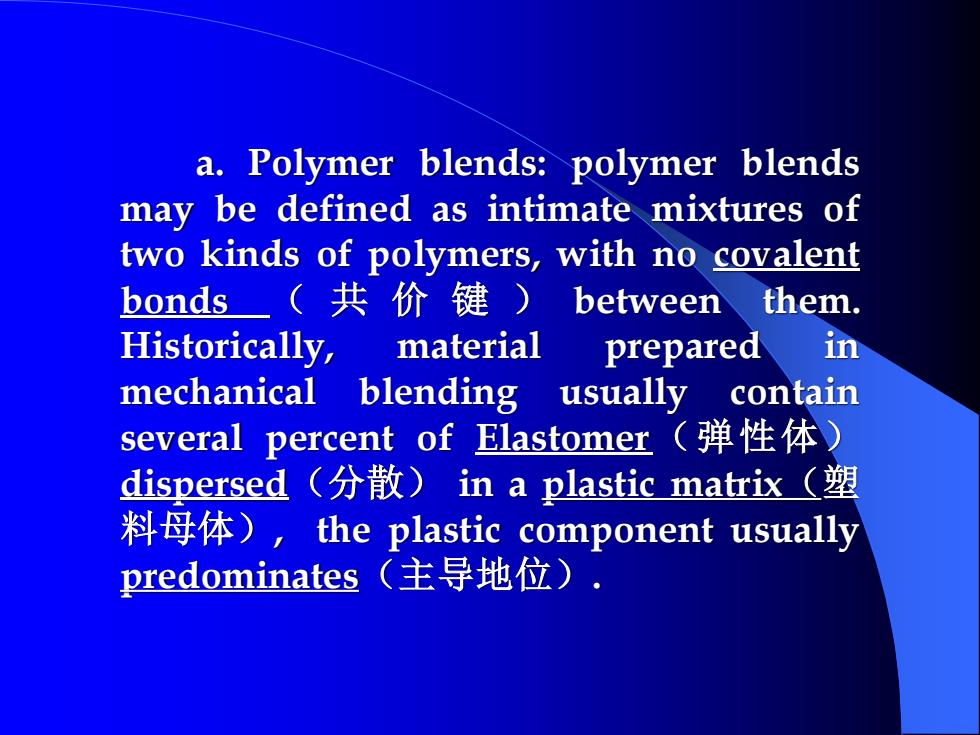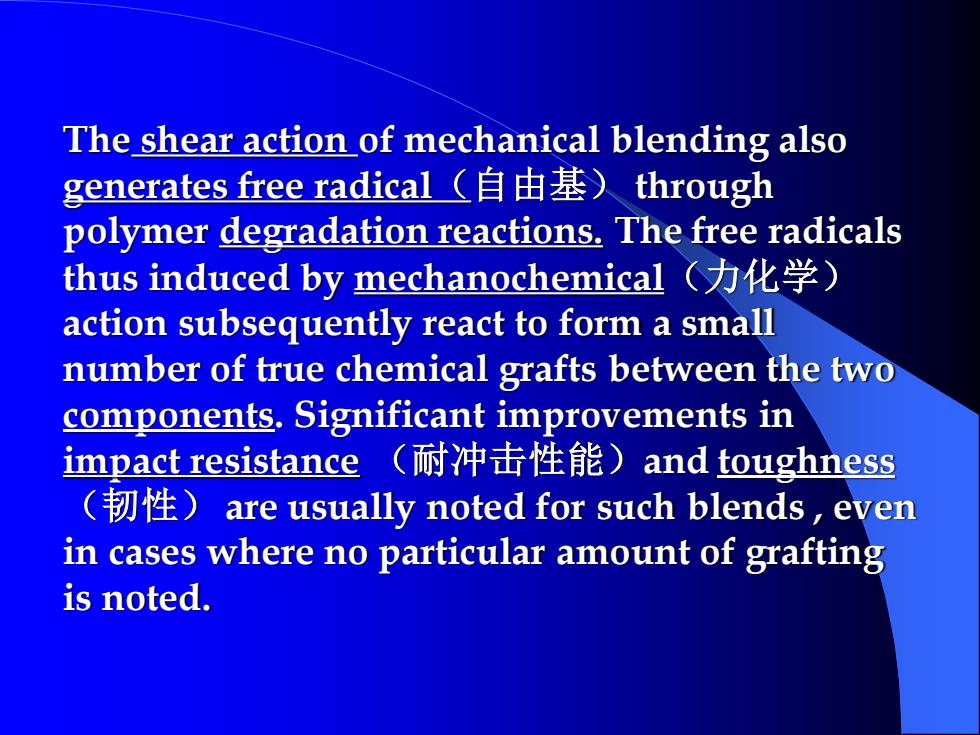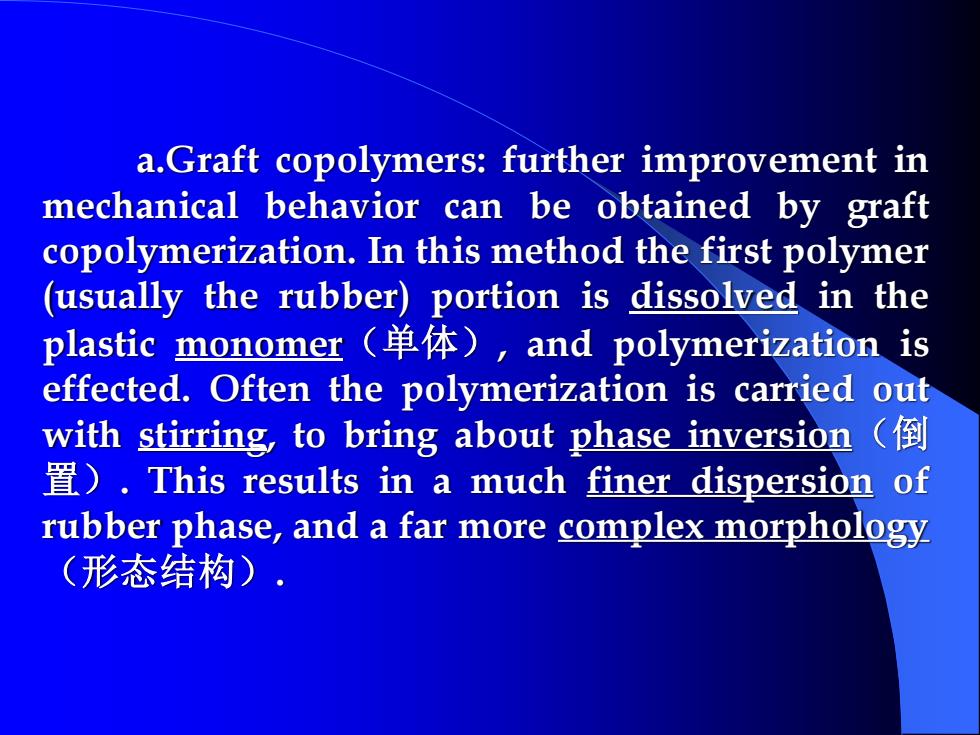
a.Polymer blends:polymer blends may be defined as intimate mixtures of two kinds of polymers,with no covalent bonds_(共价键)between them. Historically, material prepared mn mechanical l blending usually contain several percent of Elastomer(弹性体) dispersed(分散)in a plastic matriⅸ(塑 料母体),the plastic component usually predominates(主导地位)
a. Polymer blends: polymer blends may be defined as intimate mixtures of two kinds of polymers, with no covalent bonds ( 共价键 ) between them. Historically, material prepared in mechanical blending usually contain several percent of Elastomer(弹性体) dispersed(分散) in a plastic matrix(塑 料母体), the plastic component usually predominates(主导地位)

The shear action of mechanical blending also generates free radical(自由基through polymer degradation reactions.The free radicals thus induced by mechanochemical(力化学) action subsequently react to form a small number of true chemical grafts between the two components.Significant improvements in mpact resistance(耐冲击性能)and toughness (韧性)are usually noted for such blends,even in cases where no particular amount of grafting is noted
The shear action of mechanical blending also generates free radical(自由基) through polymer degradation reactions. The free radicals thus induced by mechanochemical(力化学) action subsequently react to form a small number of true chemical grafts between the two components. Significant improvements in impact resistance (耐冲击性能)and toughness (韧性) are usually noted for such blends , even in cases where no particular amount of grafting is noted

a.Graft copolymers:further improvement in mechanical behavior can be obtained by graft copolymerization.In this method the first polymer (usually the rubber)portion is dissolved in the plastic monomer(单体),and polymerization is effected.Often the polymerization is carried out with stirring,to bring about phase inversion )This results in a much finer dispersion of rubber phase,and a far more complex morphology (形态结构)·
a.Graft copolymers: further improvement in mechanical behavior can be obtained by graft copolymerization. In this method the first polymer (usually the rubber) portion is dissolved in the plastic monomer(单体), and polymerization is effected. Often the polymerization is carried out with stirring, to bring about phase inversion(倒 置). This results in a much finer dispersion of rubber phase, and a far more complex morphology (形态结构)

a.Block copolymers:In block copolymers,in a two monomers mixing system,first one monomer polymerization and the individual components are joined at their ends.The most elegant procedure follows the "living polymer"anionic polymerization process (Henderson and Szwarc 1968).The unusual features of this reaction include simultaneous nucleation and uniform growth rates of all chains,and lack of termination reactions. After exhaustion of a first monomer the polymer chains remain alive,and addition of a second monomer result in a block copolymer of the form. A-(A)n-2-A-B-(B)m-2-B Where n and m are the degrees of polymerization of the A and B per units,respectively.More blocks can be added in the same manner,if desired
a.Block copolymers: In block copolymers, in a two monomers mixing system, first one monomer polymerization and the individual components are joined at their ends. The most elegant procedure follows the “living polymer” anionic polymerization process (Henderson and Szwarc 1968). The unusual features of this reaction include simultaneous nucleation and uniform growth rates of all chains, and lack of termination reactions. After exhaustion of a first monomer the polymer chains remain alive, and addition of a second monomer result in a block copolymer of the form. A-(A)n-2 -A-B-(B)m-2 -B Where n and m are the degrees of polymerization of the A and B per units, respectively. More blocks can be added in the same manner, if desired

a. Interpenetrating polymer networks (IPN's):this novel class of polymers,together with simultaneous )interpenetrating networks(SIN's)and interpenetrating elastomeric networks(IEN's)
a. Interpenetrating polymer networks (IPN’s): this novel class of polymers, together with simultaneous (同 时) interpenetrating networks(SIN’s) and interpenetrating elastomeric networks(IEN’s)